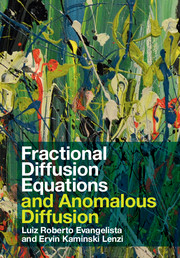Book contents
- Frontmatter
- Dedication
- Contents
- Preface
- 1 Mathematical Preliminaries
- 2 A Survey of Fractional Calculus
- 3 From Normal to Anomalous Diffusion
- 4 Fractional Diffusion Equations
- 5 Fractional Diffusion Equations
- 6 Fractional Nonlinear Diffusion Equations
- 7 Anomalous Diffusion
- 8 Fractional Schrödinger Equations
- 9 Anomalous Diffusion and Impedance Spectroscopy
- 10 The Poisson–Nernst–Planck Anomalous Models
- References
- Index
7 - Anomalous Diffusion
Published online by Cambridge University Press: 17 January 2018
- Frontmatter
- Dedication
- Contents
- Preface
- 1 Mathematical Preliminaries
- 2 A Survey of Fractional Calculus
- 3 From Normal to Anomalous Diffusion
- 4 Fractional Diffusion Equations
- 5 Fractional Diffusion Equations
- 6 Fractional Nonlinear Diffusion Equations
- 7 Anomalous Diffusion
- 8 Fractional Schrödinger Equations
- 9 Anomalous Diffusion and Impedance Spectroscopy
- 10 The Poisson–Nernst–Planck Anomalous Models
- References
- Index
Summary
The preceding chapters dealt with the fractional diffusion equation with spatial and temporal fractional derivatives, diffusion coefficients with space and time dependencies, external forces, and surface effects in finite length situations. Remarkable consequences appear also when we consider the diffusion process in the presence of anisotropy.
To analyse the anisotropic case, we first face a problem in which suspended or dispersed particles diffuse through an anisotropic semi-infinite medium. The process is described in the framework of the usual diffusion equation, but anomalous diffusion behaviour arises in the system because the phenomenon of adsorption– desorption of particles occurs at the interface, and the conservation of the number of particles in the system has to be imposed.
The second problem is to consider a fractional diffusion equation subjected to an anisotropy, with a nonsingular spatial and temporal diffusion coefficient. We will show that the distribution governed by the equation is not separable in terms of space and time variables as in the usual diffusion, which is an unexpected behaviour since the fractional operator is linear. As a specific application, the chapter closes with the search for the solutions to the comb model with integer and fractional derivatives, and also with a drift term. This model is a simplified picture of highly disordered systems and can be connected with a rich class of diffusive processes due to geometric constraints.
The Adsorption–Desorption Process in Anisotropic Media
We consider first the diffusion problem in a semi-infinite anisotropic medium in contact with a solid substrate at which an adsorption–desorption process takes place [114, 210]. Initially, a defined number of particles is suspended or dispersed in the medium and an anisotropic diffusive process starts. The particles reaching the solid substrate can be adsorbed and desorbed in such a way that the kinetics of this process is governed by a typical balance equation characterising a chemical reaction of first kind (Langmuir approximation) as the one considered in Section 5.4. The conservation of the number of particles is then invoked and the profiles of the surface as well as of the bulk density of particles are analytically obtained by means of Laplace–Fourier techniques. The results for the momentum distribution show that the system exhibits anomalous diffusion [211] behaviour, according to the values of the characteristic times entering the problem.
Information
- Type
- Chapter
- Information
- Fractional Diffusion Equations and Anomalous Diffusion , pp. 200 - 233Publisher: Cambridge University PressPrint publication year: 2018
